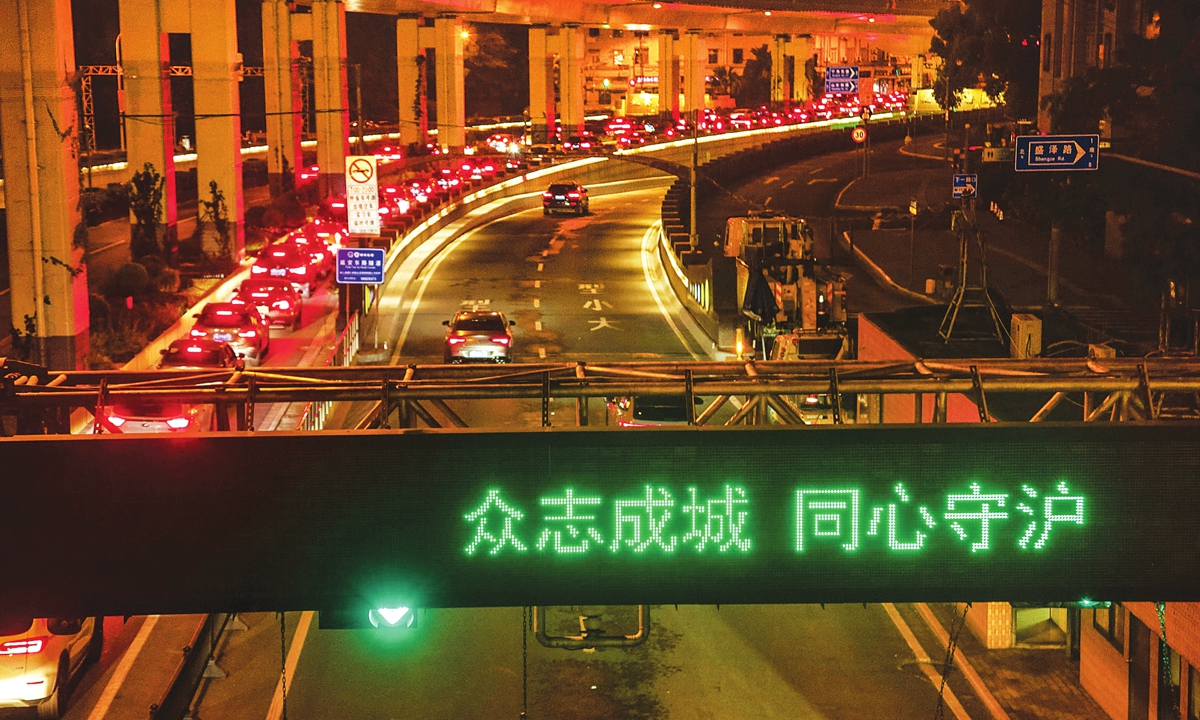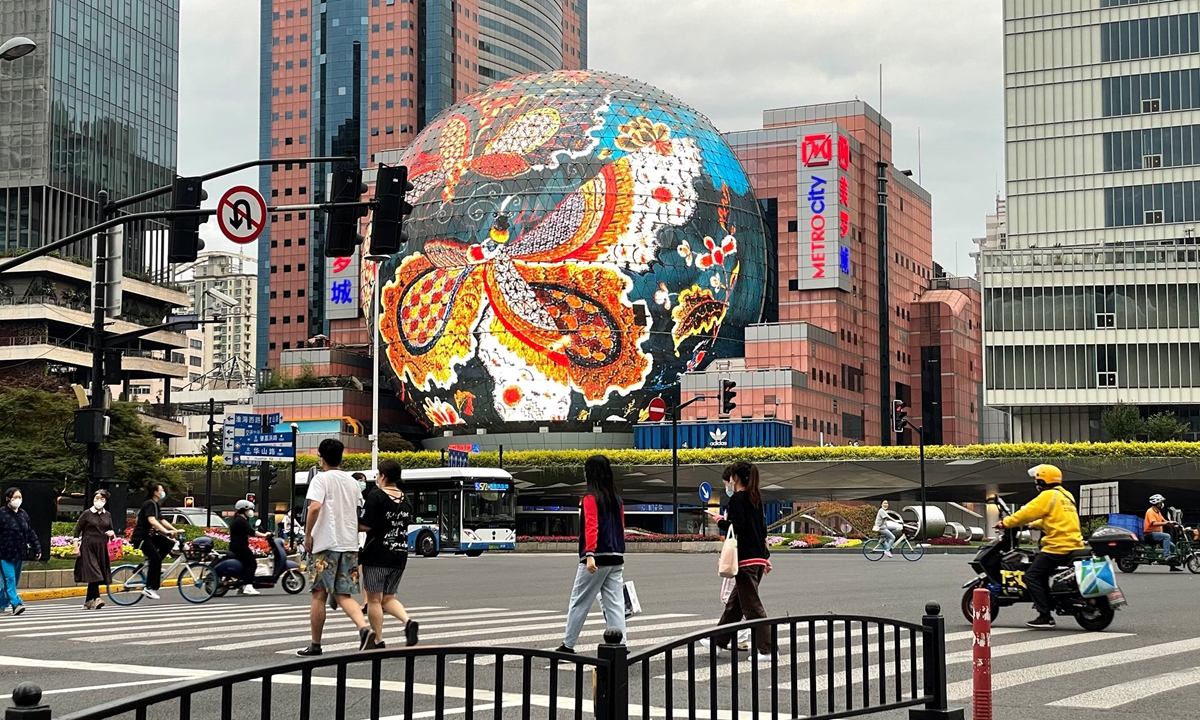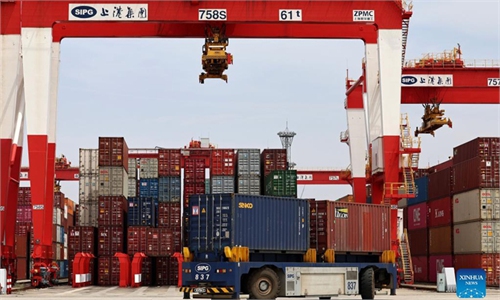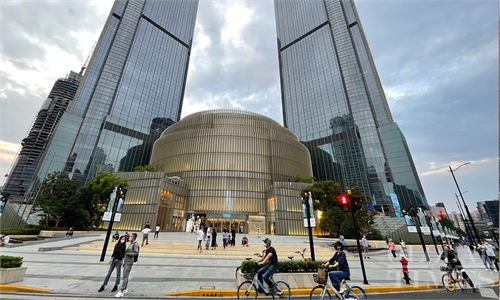Shanghai to embrace a brand new start from Jun 1
Factories, shopping malls gear up for full operation

An illuminated sign reading "Unity is strength, Safeguard Shanghai together" is seen across an overpass along the Yan'an Road in Shanghai as the metropolis sees traffic jams again after a two-month standstill at midnight on June 1, 2022. Shanghai officially ended the lockdown on June 1 to return to normalcy from the shadow of the Omicron variant onslaught. Photo: Wu Chuanhua/GT

Residents walk on the street in Xuhui district of Shanghai as the city announced to reopen residential communities, public transport and allow private vehicles on roads starting from June 1, 2022. Photo: Feng Yu/Global Times
After a two-month COVID-19 lockdown, Shanghai announced it would embrace a "new start" starting Wednesday (June 1), with free movement of people, resumption of public transportation, reopening of shopping malls, restart of factories, and the city is ready to regain the glamor of China's financial hub.
The metropolis frequently made international headlines as its handling of COVID-19 was made use of to throw mud at China's zero-COVID policy and downplay the country's economic development. However, the financial hub's recovery at the beginning of the second half of the year kick-started a strong momentum of the economic development.
The city's experience in battling the Omicron variant also propels the refinement and further fine-turning of China's zero-COVID policy. Epidemiologists predicted that returning to normal "overnight" is unrealistic, yet other local governments in China will strive to maintain a better balance when dealing with future outbreaks, as not to cut a city's basic "life lines," and to protect the GDP from suffering a big shock.
Several Shanghai residents reached on Tuesday by the Global Times said that they had received notice from their residential compound management that they were allowed to move freely starting Wednesday. Some of them had been confined at home for nearly two months.
All in-city, outbound and inbound public transportation will be resumed, as well as ferry services connecting Pudong and Puxi, the eastern and western side along the Huangpu River , Liu Bin, deputy director of the Shanghai Municipal Transport Commission, said at a Tuesday conference.
Wang Mohan, a Shanghai resident who lives in Huangpu district, said he received on Tuesday both the notice of being able to walk out of the compound and of restarting normal work starting Wednesday. "It's such a surreal feeling. Never thought I would say this, but the thing I want to do the most is go to work. I am tired of being stuck at home alone, and getting out only to open my mouth to let a swab in," said Wang.
Zeng Qun, an official from the Shanghai civil affairs bureau, warned that except for areas still under quarantine, no entities or people can restrict residents from going out or coming back.
Yin Xin, the municipal government spokesperson, said that the Shanghai COVID-19 briefing won't be held daily anymore as the city is embracing a "new start" since Wednesday.
Medical groups from Hubei Province and from the People's Liberation Army, which were sent to help Shanghai battling the outbreak months ago, announced on Tuesday that they've accomplished their tasks and are leaving the city.
The city reported nine confirmed COVID-19 cases, and another 22 silent carriers. A total of 200,000 people are still under quarantine.
Necessary antivirus measures stay unchanged. Residents need a 72-hour valid negative nucleic test before entering public places and taking public transportation. The government also put a cap of 75 percent of the maximum capacity on commercial sites, including shopping malls.
Some Shanghainese also tried to shake off the slovenliness left by the lockdown. Li Cuihua, a Shanghai resident, said people in her compound are "group buying" a barber on Tuesday, who agreed to give them a hair in their houses if at least five people are in for the deal.
On full engine
The two-month lockdown in Shanghai - China's financial hub - has disrupted the country's economic development, which propelled speculation from foreign media that painted a grim picture of China's economic development this year.
On Sunday, city officials said they would remove "unreasonable" curbs on businesses starting June 1, including scrapping its "whitelist" of companies that had been allowed to resume operations during the city's lockdown.
Veteran Beijing-based economist Tian Yun told the Global Times on Tuesday that based on what he learned from multiple companies in the car industrial chain in Shanghai as well as in nearby Jiangsu and Jiangxi provinces, many of them have started to resume production, while their manufacturing schedule for June is full. He learned from some Shanghai- and Jiangsu-based factories that their employees' work resumption rate should be able to return to pre-pandemic levels by early June.
"From what I observed, many companies' real problem is not a lack of orders, but interrupted supply chains. Some progress has been made in the latter problems after the central government made repeated requests to smoothen logistics," Tian told the Global Times on Tuesday.
The China-Europe Freight Train transport service in Shanghai has resumed on the express line, after the city eased COVID-19 measures. Carrying 49 containers of mechanical equipment, one train left Shanghai for Rostov Oblast, Russia on Sunday.
Statistics show that at the end of May, the throughput capacity of containers of the Port of Shanghai has resumed to 95.3 percent of pre-outbreak levels. Throughput capacity of the port has increased 1.9 percent in the first four months this year, compared with the same period last year.
Shanghai's shopping malls are also gearing up to stimulate consumption, ahead of the three-day Dragon Boat Festival, which starts on Friday. French retailer Carrefour's Shanghai branch told the Global Times that they plan to issue vouchers for Shanghai consumers during the holidays, including half the price for some imported wines, so "Shanghai people who just walked out of the COVID-19 shadow can enjoy a beautiful life."
China's central and local governments unveiled measures to power the economy in the latter half of the year, including relaxing taxes for certain sectors, subsidies for small enterprises to ferry them through the predicament, and ensuring the smooth flow of domestic and international logistics channels.
Chen Jia, a research fellow at the International Monetary Institute of the Renmin University of China, told the Global Times on Tuesday that since the recently announced stimulus policies will be implemented in the second and third quarter, chances are great that the economy will witness a robust rebound in the second half of 2022, and intense GDP volatility during the two quarters will be unlikely, unless there are unexpected factors like a coronavirus resurgence or more serious external geopolitical tensions.
Pave way for the future
As Shanghai hopes to return to normal, many are also concerned about the possible return of major outbreaks and a sudden slap of lockdowns. Epidemiologists predicted that the risks of fresh COVID-19 flare-ups and a return to restrictive measures still exist as the fundamental loopholes, such as a low vaccination rate among elderly and inadequate medical resources to handle an exit wave, remain unimproved, plus the newly discovered coronavirus variants.
Zeng Guang, former chief epidemiologist of China's Centers for Disease Control and Prevention, told the Global Times on Tuesday that there's no such thing as a return to normal overnight. "The government is fine-tuning the zero-COVID policy in accordance with the status quo," he said.
The principle, Zeng said, is to maintain a low mortality rate, keep people's lives unaffected by the outbreaks, and protect the GDP from suffering a huge blow.
The financial hub's tussle with Omicron also exposed problems, and draws valuable experiences for future battles with Omicron, or other new variants.
In order to handle the flare-ups in Shanghai, the municipal government explored a combination of antigen and nucleic acid tests, approved the use of Pfizer's oral COVID-19 drug Paxlovid, and experimented with other domestically researched COVID-19 drugs, Zhuang Shilihe, a Guangzhou-based medical expert, told the Global Times, noting that this round of outbreaks also shed light on the low vaccination among the elderly group.
Shanghai reported more than 500 deaths, and only 4.97 percent of them received vaccines. The city, which has one of the lowest vaccination rates among people aged 60 years old and up, edged up with efforts to boost shots. Many district governments in recent days encouraged old people to get vaccinated, including offering home visits.
The municipal government said that 62.11 percent of the city's population aged above 60 have been fully vaccinated.
After epidemiologists realized speed is the key to contain the highly contagious Omicron, the government began to set up COVID-19 testing booths within a 15-minute walk in all major cities; and required short-term negative tests results in most public places. Measures that prop up the "normalized COVID-19 prevention and control" also helped to detect any virus carrier as quickly as possible.
Zeng pointed out that when it comes to antivirus measures, a city and its residents' "life lines" should be maintained, which means a supply of life necessities, and treatment of patients must not be suspended or interrupted.
Shanghai bungled maintaining "life lines' for people at the early stage of the outbreaks as some residents complained about a lack of food, and difficulties in getting medical treatment. Local government later took measures to smooth the problems as complaints fermented.
With precedents from Shanghai, Beijing, which also faced the onslaught of Omicron on heels of Shanghai, stressed a smooth supply of food, and guaranteed residents' access to medical services since the start of the outbreaks when it tightened antivirus policies. After 37 days, the capital started to ease restrictions as cases dropped to a trickle.
"During an outbreak, not only the virus is propagating, so is people's depression. Only when the problems were under control will the public be more cooperative with restrictive measures," said Zeng, confident that future policies will strike a better balance between controlling COVID-19 and maintain people's lives.
Li Xuanmin and Feng Yu also contributed to the story





